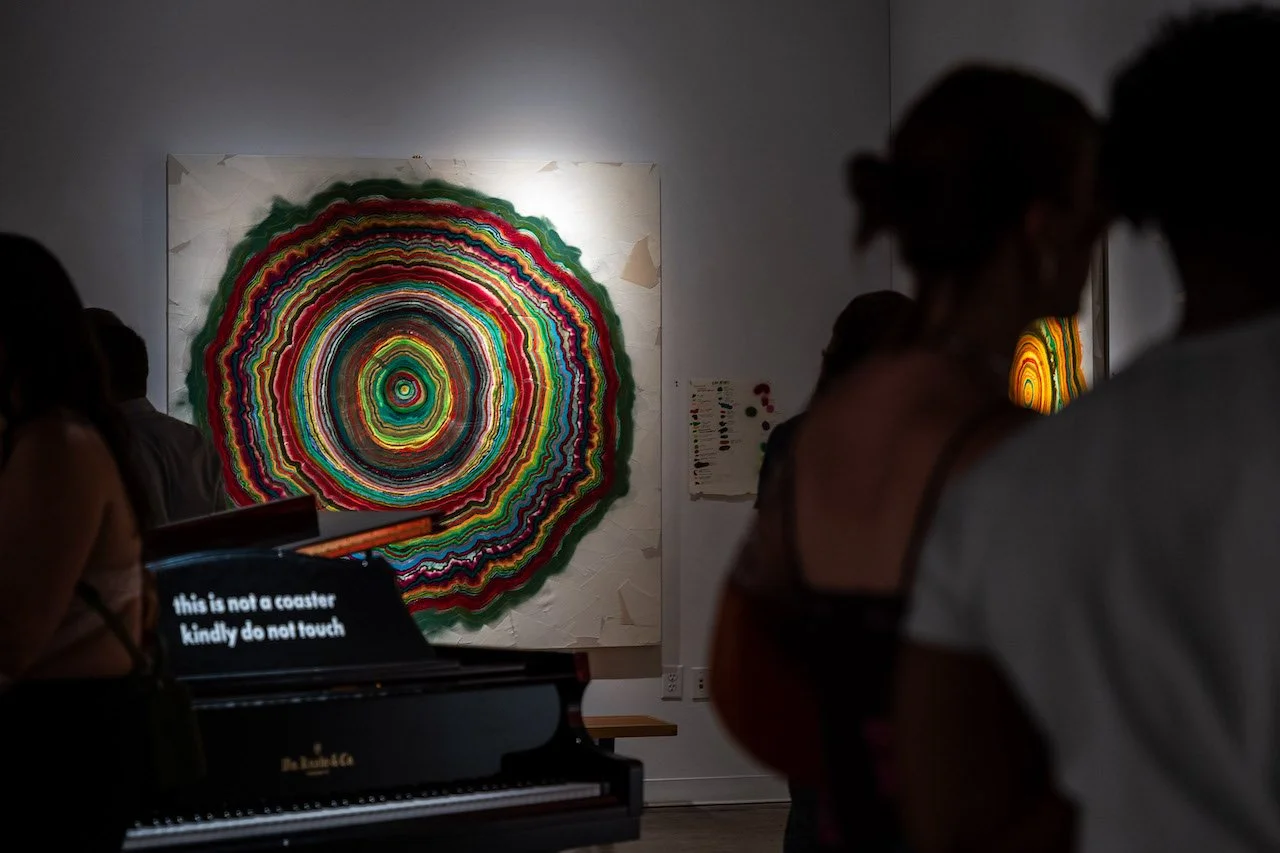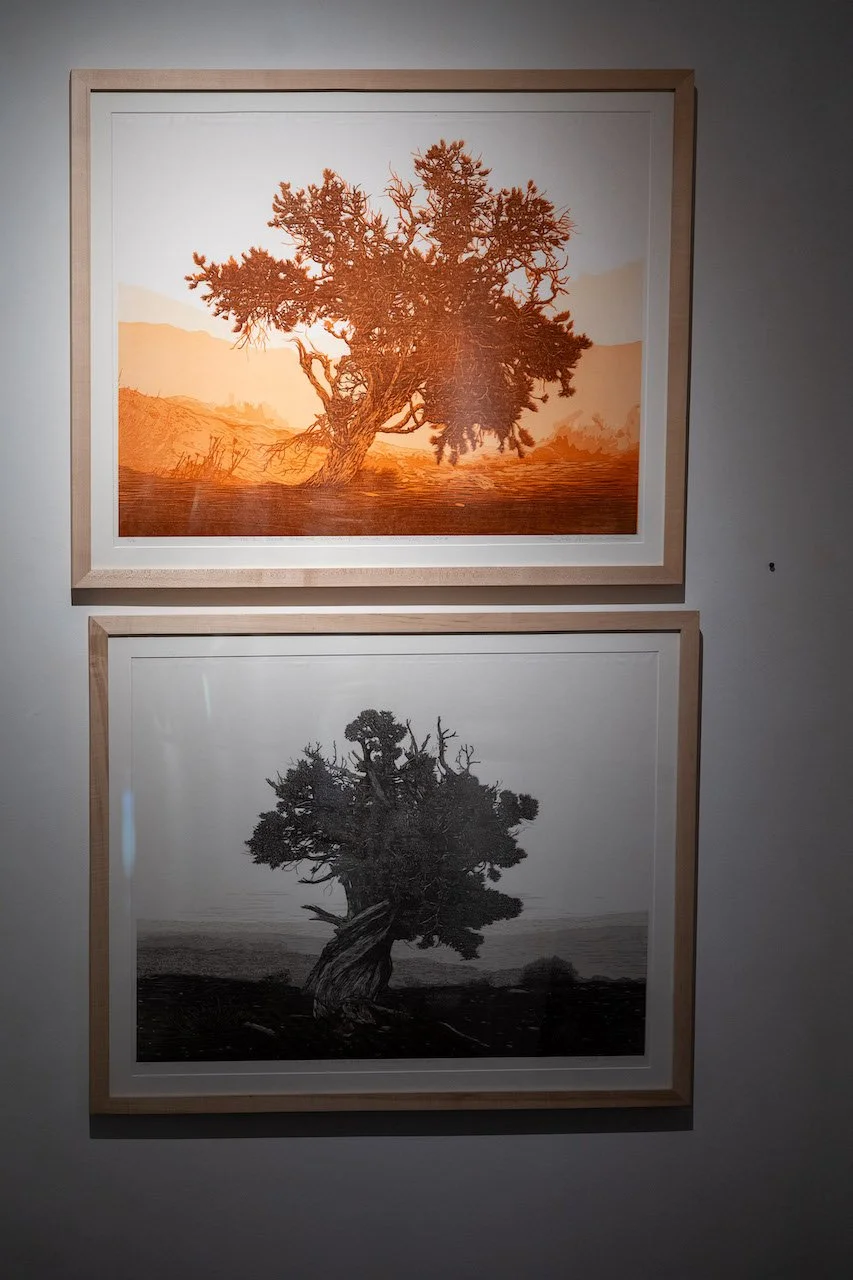“Narratives” at Kai Lin Art, installation view. (All photos by Valentin Sivyakov Photography)
Capturing stories, thoughts and moments in life can be an artist’s way of sharing who they are and showing it to the world in the most vulnerable way. When you group several artists with varied mediums and demographics, how do you find their commonality? Finding a common thread between artists requires seeing the work from their perspective, laced with their emotions and histories. Kai Lin Art’s current exhibition, Narratives, running through July 12, includes the works of Steven L. Anderson, Todd Anderson, Kiara Gilbert, Landon Perkins and AD “Kaya” Clark, working here under the name Kaya Faery.
Upon walking in, you’re immediately met with Steven L. Anderson’s Tree Rings, which are full of color and energy and portray the vitality of nature and the wisdom it carries. Anderson draws these concentric circles with markers, pens, oil sticks and ink, and the tree rings take shape as each line expands and builds the form into existence, which is full of vibrations reminiscent of what we feel when outside in nature.
Steven L. Anderson, “240 years”.
“My artwork is about the power of nature and the nature of power,” writes Anderson in an artist’s statement. “I have a creative practice that looks to trees and plants as an evergreen source of metaphors for how we experience the world.” Anderson continues, defining his artistic goal as “to make images, things, spaces and situations that fuse the exhilaration of the human spirit with the ferocious beauty of nature to make a palpable, tingling essence.”
Color studies accompany Anderson’s paintings in “Narratives.”
As someone who sees power in the outdoors and the arts, I appreciate Anderson’s Tree Rings being complimented by meticulously labeled color studies, connecting the process to the final form. The works are titled based on the number of lines or, better yet, the years the rings display. The work at the front of the exhibition is titled 240 Years and is striking with the varying use of color and weight of each line in the tree ring. Anderson’s work in the gallery space brings an essential feeling of rest and joy and takes a central focus among the four other artists being exhibited.
Through the gallery’s idiosyncratically shaped space, there are vignettes of the featured artists spotlit to hold the viewer’s attention. Being an independent curator over the last several years, I tend to read the room in an attempt to understand how the art and artists connect to one another. As I move through, I’m stopped by a grid wall of Todd Anderson’s (no relation to Steven) intaglio photopolymer gravure prints of the series, The Last Glaciers of Akshayuk Pass {Baffin Island}. The artist traveled north of the Arctic Circle on Baffin Island to study the Penny Ice Cap and its retreating glaciers, and these prints are a result of his studies and documentation of the land.
Todd Anderson, “Moulin on Turner Glacier, Baffin Island” (l) and “Melt on Parade Glacier, Baffin Island”.
Regarding this series, Anderson’s artist statement explains, “I have logged over 500 miles on and off trail hiking to the individual glaciers to sketch, watercolor and/or photograph them.” The intricacy and meaning of the prints are further explained as being “drawn with needles and the aid of a magnifier, [offering] extreme amounts of detail that seek to portray the complexity and dynamics of the natural world.” The relational aspect of both Steven Anderson’s and Todd Anderson’s works linked to nature builds on the colloquialism “to stop and smell the roses” with a micro-dive into their personal perspectives.
Work by Kiara Gilbert (installation view).
Continuing to maneuver through the exhibition, I come upon the work of two Black artists, Kiara Gilbert and AD “Kaya” Clark, shifting the perspective of the nature narrative to one that centers blackness and our relation to queerness and selfhood. While different in subject, these works are placed together but siloed from the others in a nook adjacent to the washroom. I can’t help but ask myself, during my personal interrogation of the placement within the gallery, if the optics of placing the two Black artists in an alcove near the washrooms had been fully considered. Nonetheless, I stayed with Gilbert’s work, reading into the emotion of their carved woodblocks covered with black acrylic paint.
Kiara Gilbert, “Out of Reach”.
Gilbert’s artist statement expounds that their work “explores how emotional landscapes are shaped and perceptions of history are misinformed by colonized narratives surrounding the past.” The carved lines into wood create a marker of pain and memory seeking to reclaim the distance the Black community has placed on queerness throughout history. The five-foot die cut relief carving of a figure, Out of Reach entices you to reach back and envision the artist’s own experience and the layered ancestral past. A clear throughline of connective tissue in Gilbert’s work represents the narrative of resilience and loss.
While a Google search on the word “narrative” produces the definition “a spoken or written account of connected events; a story,” how we interpret the artists in this exhibition goes back to the idea of nature versus culture. Our personal narratives can affect how we receive artists’ visual language, and this exhibition could be a vehicle by which to understand more of who each of us is and what we understand of the world.
::
Lauren Jackson Harris is an Atlanta-based curator, consultant and writer. Harris is also the Founder of Black Women in Visual Art and serves on the Board of Directors for Dashboard and will be curating a section of the Inaugural Atlanta Art Fair in 2024.































































































































